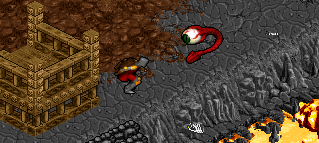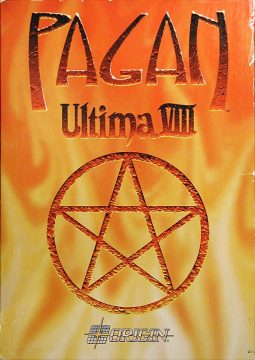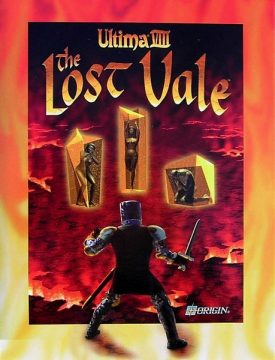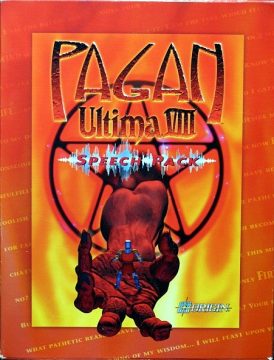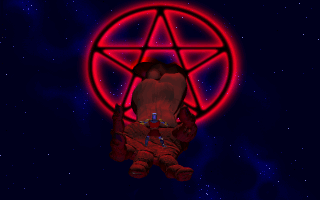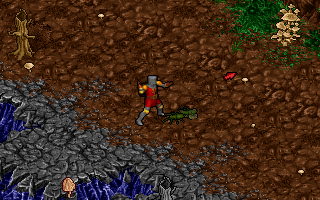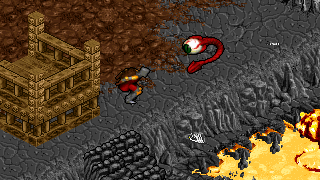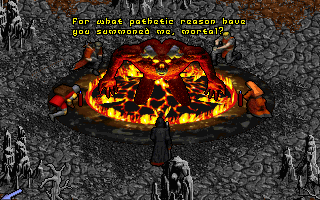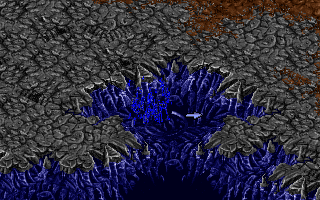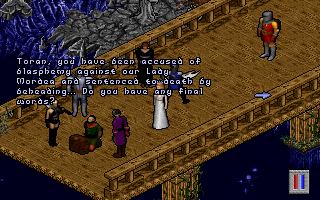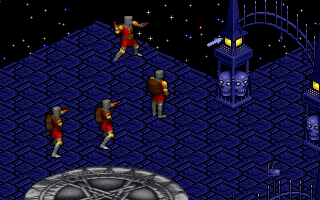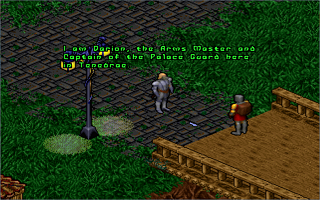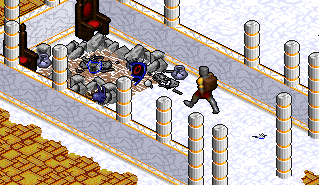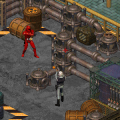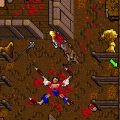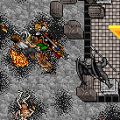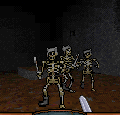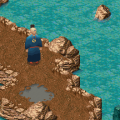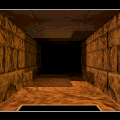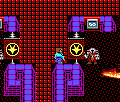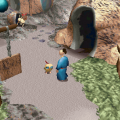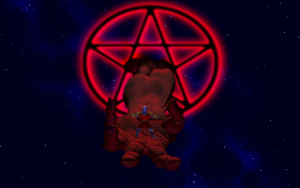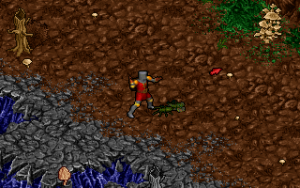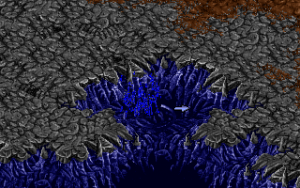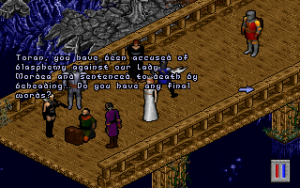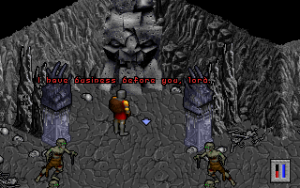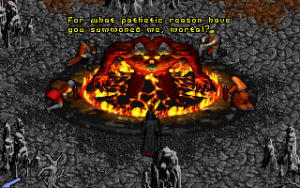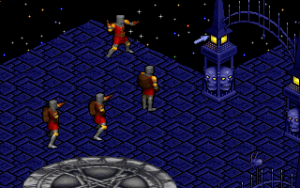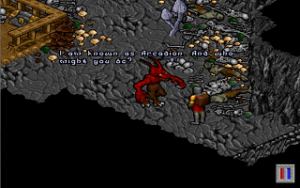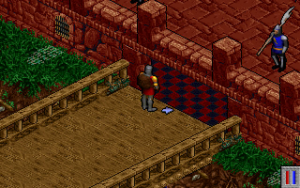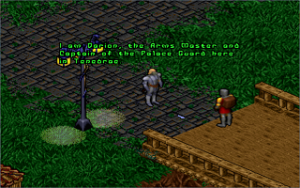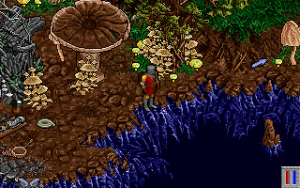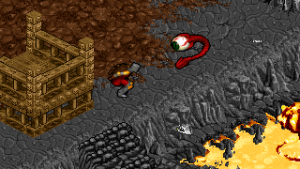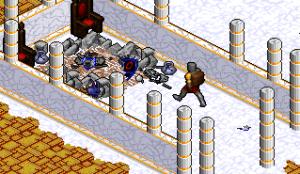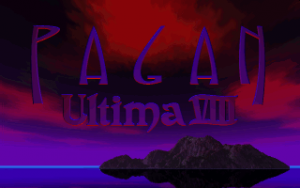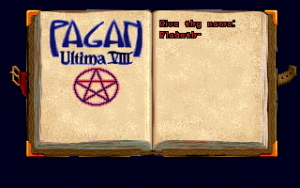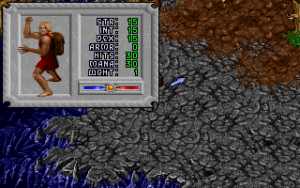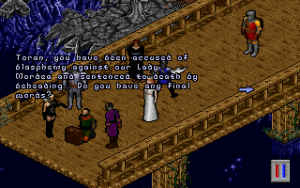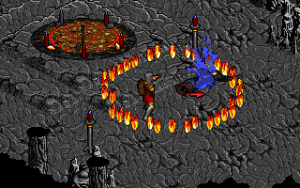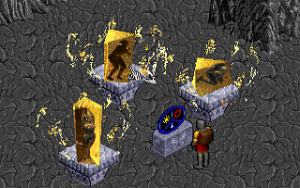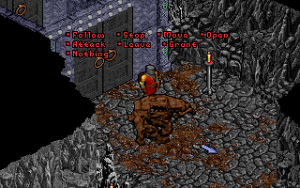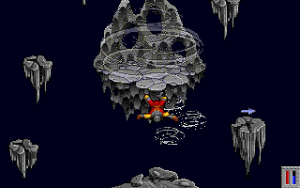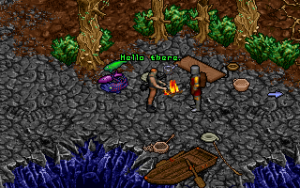- Ultima (Series Introduction)
- Akalabeth
- Ultima I: First Age Of Darkness
- Ultima II: Revenge of the Enchantress
- Ultima III: Exodus
- Ultima IV: Quest Of The Avatar
- Ultima V: Warriors of Destiny
- Ultima VII: The Black Gate
- Ultima VI: The False Prophet
- Ultima VII Part 2: Serpent Isle
- Ultima VIII: Pagan
- Ultima Underworld: The Stygian Abyss
- Ultima Underworld II: Labyrinth of Worlds
- Arx Fatalis
- Worlds of Ultima: The Savage Empire
- Ultima Worlds of Adventure 2: Martian Dreams
- Ultima IX: Ascension
- Lord of Ultima
- Ultima Online
- Ultima: Escape from Mt. Drash
- Ultima: Miscellaneous
- Richard Garriott (Interview)
You have been a thorn in my side for far too long, Avatar. Your two worlds will be crushed, Britannia first, then Earth! I shall parade you before their conquered peoples as the fallen idol of a pathetic ideal. I banish you to the world of Pagan! No one here knows of thee, Avatar…
At the end of Serpent Isle, the Guardian, having his plans foiled for a third time by that uppity Avatar, decides to remove you as a threat and imprisons you in his own home world, Pagan, a blasted and oppressive place where Evil has already won. If the Age of Enlightenment trilogy of games was about building up what it means to be a hero, the Guardian Saga is about creating a world gradually darker and darker. As the Guardian attests, neither you nor your Britannian virtues are known on Pagan, and the world is an lost, hopeless place that you cannot save. The sky is perpetually black and clouded, the seas are full of murderous monsters that pull the unwary in, and the entirety of the world has been reduced to a single volcanic island which could erupt at any moment, wiping out all that remains of the wretched surviving civilization. The object of the game is simply to escape Pagan, by reconstructing the original Black Gate from Pagan to Britannia that you destroyed in Ultima VII. Doing so involves bringing suffering to the people of Pagan, however, by overthrowing their magical providers, the four Elemental Titans, for your own ends. Richard Garriott sums his vision up for the game best, and he is here quoted verbatim from a Gamespot interview:
“With Ultima VIII, I wanted to be even more severe with the sinister elements. That’s where your character went off to the land of Pagan, which was the Guardian’s home world. This world wasn’t your standard, virtuous goody-goody-two-shoes setting, to the point where if you tried to uphold the goody-goody-two-shoes life in the game, you couldn’t get anywhere. The challenge was that you had to stay true to your core personal beliefs without totally ransacking the place to achieve your ends and work with the system that was there. The storyline is basically one of those “sometimes you have to fight fire with fire” stories where, when you’re faced with true evil, you’ve got to cheat in order to win.”
Ultima VIII: Pagan is a completely different game from any other in the series, even moreso than the notoriously unusual Revenge of the Enchantress. Richard Garriott focused strongly on the audiovisual aspects of Pagan in the design. Returning to the hack-and-slash style of the Age of Darkness trilogy, Pagan includes arcade-like action elements galore, including jumping, climbing and a combat emphasis. The animation is given particular attention, and is detailed and flowing, resulting in a game that looks much better in motion than earlier series entries. It sounds better as well, with support for all the latest sound cards of the time and full digital sound, including an impressively forlorn and eerie set of ambient background music and speech for all the major villains and several other characters.
Though the game world is much smaller than in The Black Gate or Serpent Isle, special attention was given to make sure that every area stood out in a punchy way. In fitting with being far from Britannia, the same magic system of prepared reagents present since Ultima IV is no longer usable on Pagan. Ultima VIII instead has five entirely new magic systems, each governed by an elemental titan, and each has its own separate mechanics. Theurgy, the Magic of Air, requires the forging of special amulets for each spell which can then be used as long as the caster has mana, while Sorcery, the magic of Fire, requires an elaborate magical ritual to prepare spells beforehand. Necromancy, the magic of Earth, requires reagents gathered into a bag and then “opene” with a magic key, and Thaumaturgy, the magic of Ether, is cast from spell scrolls created from words of power. (Tempestry, the magic of Water, cannot be learned in-game; this system was cut for time constraints).
The scenario of the game is also a high point; it is simply not possible to escape Pagan without doing evil, and Ultima players who have spent the last ten years following the ways of Virtue now must accept that some evil must be done for the sake of the greater good. Rebuilding the Black Gate requires, in essence, infiltrating the schools of magic, stealing their secrets, and then murdering their gods while somehow remaining as true to the ideal of the Avatar as possible. It’s a fantastic concept.
That’s the good that can be said. Ultima VIII tries, it really does. It was made with big ideas, big aspirations and the best of intentions. It is, unfortunately, a steaming pile to actually play. The game could charitably be said to have been released unfinished, several months so according to the developers. The game is several steps backwards from Ultima VII. The world is tiny (with an abysmal lack of NPCs to interact with), has no character creation (so all Avatars are faceless and male), has no character portraits, no party members and much less world interactivity. Despite being an action game, the action sequences are implemented very poorly. Without a later patch, the Avatar’s jumping is a nightmare to control, and several segments of the game include jumping puzzles which are nearly impossible to bypass. The game’s balance is absolutely horrible: once you acquire the Rock Flesh or Intervention spells (possible fairly early on), which make you completely invincible for a lengthy amount of time, combat becomes utterly pointless and trivial, a mere irritating distraction. Infamously, the Avatar is violently allergic to the slightest contact with Pagan’s water, and like the Wicked Witch of the West melts into oblivion should he ever step into even the most seemingly shallow puddle. One of the Titans the player must slay lives in a cave full of water. You can already hear the screaming.
For the development of Ultima VIII, Electronic Arts had put Origin on an uncomfortably tight deadline; the dev team worked in hellish sweatshop conditions, development was rushed, and the game shipped in what is clearly an unfinished and unpolished state. Countless glitches and bugs made the game originally near unplayable, and the combination of awkward controls with the three-quarters isometric viewpoint make moving around the world a clumsy affair, defeating the purpose of the game’s hundreds of frames of lovely animation for the Avatar. In addition, egregious amounts of content from the game was cut in an effort to stay on EA’s imposed timetable. Among other notable absences are an entire school of magic, an underwater city mentioned but never visitable, the Guardian’s Palace (mentioned in Ultima Underworld II but inexplicably absent here), and many missing plot events, untriggerable event flags, unreachable dialogue, and mysterious passageways and doors that go nowhere. Much of the cut content can be reconstructed from dialogue and events left in the game’s code, and fans have compiled lengthy lists of it. It seems that Pagan was originally going to be a much more complex game, with several hours worth of additional puzzles and mysteries, and more characters and quests than what made the cut for the final game.
Origin Systems did eventually release an official patch that makes Pagan far more playable than the original release, including features like targeted jumps, useful keyboard shortcuts, more forgiving item placement, removing the Avatar’s irritating tendency to fall down and hit his head after every other hit in combat, the total removal of all jumping puzzles (moving platforms now hover in place), and hundreds of major and minor changes largely inspired by fan feedback; installing the patch is absolutely essential, allowing you to enjoy the game instead of cursing about jumping puzzles. With the patch also came a letter from Richard Garriott to his fans, explaining the design goals of the game and the rationale behind some of the design decisions. This letter is attached to this article (FANS.TXT). It’s hard not to be sympathetic about the game, no matter how aggressively it seems to want you to be the fiftieth time the Avatar falls into a shallow puddle and drowns.
Pagan was the first new Ultima game to be launched on the CD-ROM format. Around late 1993 and early 1994, Electronic Arts had begun to rerelease many of the older games they had rights to on compact disc (including the previously-discussed Complete Ultima VII), as well as all of their new games. While the 3.5″ disk would still be be used as a convenient form of re-writable storage among computer users for some years yet, the CD-ROM had essentially taken over the computer industry and there was no looking back. While Pagan was released in both a CD-ROM and a disk version, the CD edition is superior due to the inclusion of recorded voices for the Guardian, the four Elemental Titans and a select number of other characters. Players of the disk version of the game could buy a Pagan Speech Pack expansion which would add those voices in. The Speech Pack expansion never sold well, for fairly obvious reasons.
Ultima VIII: Pagan was a disappointing seller and received average to mediocre reviews from game publications of the time. The poor sales performance of Pagan resulted in Electronic Arts canceling a planned Enhanced CD version of the game which would have been released in late 1994 and included character portraits and full voices for every character, among other new features, as well as the expansion. Like The Black Gate and Serpent Isle, Pagan was originally going to receive an expansion adding additional content into the game as well as patches and general bugfixes and upgrades. Titled The Lost Vale, the expansion would have explored the history of the world of Pagan and much expanded the relatively small world that made it into the final game. Work on The Lost Vale was completed and the game was reported as having gone gold (ready to be duplicated for manufacture), when EA decided not to release. The code and work for The Lost Vale has, according to designer Sheri Graner Ray, been since lost; all that remains of it now are screenshots and one copy of the game box, currently in the hands of an unknown German collector. Presumably, the extra development time to polish Pagan would have resulted in a far better game than what we received.
Like the engines for the last two games, Origin managed to get some extra mileage out of the game’s code. The Pagan engine was later upgraded and used by Origin to create their Crusader series, entertaining isometric action games which show what Ultima VIII could have been with just a bit more time.
Links:
Official Pagan patches by Creative Labs and Origin Systems to include Sound Blaster AWE32 support and fix numerous game bugs (Patches should be installed through DOSbox and do not work in Windows)
Pagan’s introduction movie
Pagan help and walkthroughs on the Ultima Web Archive. Includes screenshots of The Lost Vale
The unofficial Pagan FAQ, archived
Sheri Graner Ray, discussing the cancelled The Lost Vale expansion
The Lost Vale on PC Games that Weren’t
Pagan Enhanced CD on PC Games that Weren’t
Ronald ‘Gaseous Dragon’ Windeyer’s page including information on how to run Pagan under Windows
List of known cut content in the game. (Major plot spoilers by nature of the material)
